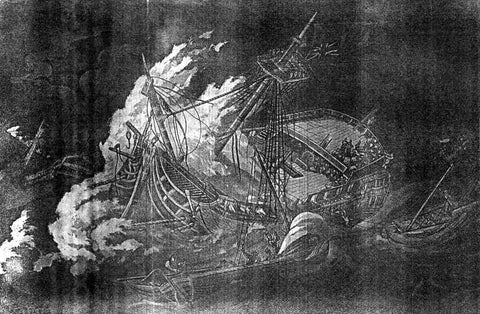
These copper coins were minted in England, for the British East India Company (EIC), in 1808.
They are some of the first coins in the world to be minted by steam power, at the Soho Mint in Birmingham, England. The Soho Mint was created by the great industrialist Mathew Bolton, and his partner, James Watt of steam power fame. Watt developed the concept of “horsepower” and the International System of Units (SI Unit) of the watt or “wattage.”
They were meant to be used at EIC trading posts in India. Packed in wax, they were loaded on board the proud British East Indiaman, Admiral Gardner, to make the treacherous journey. But on January 24, 1809, she was caught in a storm in the English Channel and sank on Goodwin Sands, never to be seen again until 1985.
If this copper trade coin looks almost perfect, it’s because it is! Carefully minted with the all-new steam presses of the industrial revolution for the mighty British East India Company, they didn’t even make it out of the English Channel, sinking on the treacherous Goodwin Sands at its northern end.
Although the East India Companies were almost all-powerful – at their height commanding trading ports, a standing army, and the economy of their namesake country, they were powerless against one thing – Mother Nature. But the spoils to be won – the money to be made – through international trade more than offset the risks for generations of adventurous businessmen, naval commanders, pirates and privateers.
But on January 24, 1809, Admiral Gardner, having set sail shortly before, was to become a footnote in history. Her Master, Captain William Eastfield, takes up the narrative: “We sailed out of the Downs on the 24th, with the Carnatic and the Britannia, the wind from the eastward. On getting a little to the westward of the South Foreland, the wind drew to the south-east, and about dusk fell calm: it being flood tide, let go the anchor in fourteen fathom water. At 7pm, while giving the ship cable, the wind sprung up from the west-north-west. The people were sent up to hand sails immediately, but the wind increasing violently, they could not effect it. The people continued on the yard until 10pm: the pilot then feeling the lead, called out the anchor was coming home; the people were consequently called off the yards to give the ship cable, and when I was below seeing a little more service clapped on, a little before eleven I heard the pilot exclaim ‘cut away the sheet, the ship’s on shore.’”
Gone to the bottom were a King’s ransom in trade goods, and the shinning copper Cash Coins to be used in trading posts in India.
And if not for modern treasure salvors, the story would end there. But in 1985, the adventurous spirit of those East India Company ancestors emerged in a new generation of Englishmen who recovered the lost treasure of Admiral Gardner.
Historic Note by Robert: The Downs, between the Strait of Dover and the Thames Estuary, is a sheltered area in the southern part of the North Sea, and the northern part of the English Channel just south of Ramsgate and Dover. During the age of sail, it was an anchorage for refitted and new ships coming out of Chatham Dockyard, and where EIC ships laid to, waiting to catch east winds that would take them to the Indies. It is protected on the east by the treacherous Goodwin Sands, a 10-mile long sand bank, six miles off the White Cliffs of Dover. Historic records indicate that at as many as 800 ships would lay anchor at one time. It is estimated that more than 2,000 ships have met their fate on “the Goodwins,” including EIC Admiral Gardner and the Dutch EIC ship VOC Roosvijk of which make up some of our sunken treasure collections.
CANNON BEACH TREASURE COMPANY EXCLUSIVE: We’re proud to say our collection was once a part of the salvage dive-master’s personal collection, whose signature is on our detailed, multi-page Certificate of Authenticity. This coin is a beautiful example of recovered shipwreck treasure, now destined for a very different future as it travels on with you.
To see our selection of Admiral Gardner coins and jewelry, click here>

